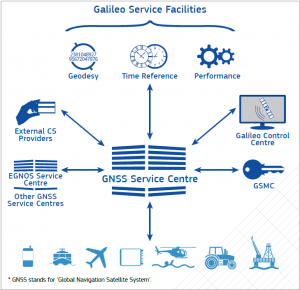If you wish to contribute or participate in the discussions about articles you are invited to contact the Editor
Galileo User Segment
| GALILEO | |
|---|---|
| Title | Galileo User Segment |
| Edited by | GMV |
| Level | Basic |
| Year of Publication | 2011 |
The Galileo System is an independent, global, European-controlled, satellite-based navigation system and provides a number of guaranteed services to users equipped with Galileo-compatible receivers.
The Galileo system is divided into three major segments: Space Segment, Ground Segment and User Segment. The Galileo User Segment is composed by all the compatible receivers and devices which collect the Galileo signals, determine pseudoranges (and other observables), and solve the navigation equations in order to obtain their coordinates and provide accurate time synchronization. There are different user’s communities depending on the application and covering a wide range, from transport to timing applications.
Basic elements of a generic GNSS Receiver are an antenna with pre-amplification, an L-band radio frequency section, a microprocessor, an intermediate-precision oscillator, a feeding source, some memory for data storage, and an interface with the user. The calculated position is referred to the antenna phase centre.
Galileo Receivers
A Galileo Receiver is a device capable of determining the user position, velocity and precise time (PVT) by processing the signal broadcasted by Galileo satellites.
Any navigation solution provided by a GNSS Receiver is based on the computation of its distance to a set of satellites, by means of extracting the propagation time of the incoming signals traveling through space at the speed of light, according to the satellite and receiver local clocks. Notice that satellites are always in motion, so previous to obtaining the navigation message, the satellite’s signal is detected and tracked. The receiver’s functional blocks that perform these tasks are the antenna, the front-end and the baseband signal processing (in charge of acquiring and tracking the signal).[1]
Once the signal is acquired and tracked, the receiver application decodes the navigation message. The navigation data contain all the parameters that enable the user to perform positioning service. The types of data needed to perform positioning are:[2]
- Ephemeris which are needed to compute the position of the satellite to the user receiver.
- Time and clock correction parameters which are needed to compute satellite clock offsets and time conversions.
- Service parameters with satellites health.
- The ionospheric parameters model, needed for single-frequency users.
- Almanac which allow less precise computation of the position of all the satellites in the constellation to facilitate the initial acquisition of the signals by the receiver
For single frequency receivers, the Broadcast Group Delays are also needed.
In 2010 there were only three chipset manufacturers producing Galileo-ready products. Since them, the market has been evolving, and today it is ready for Galileo. The list of Galileo compatible devices that are available today can be found at the following reference [3].
Service Centers
The European GNSS Service Centre (GSC) aims at providing a single interface between the Galileo system and the Galileo Open Service (OS) and High Accuracy Service (HAS) users for the provision of specific services beyond the signal in space transmitted by the satellites. The GSC assures knowledge sharing, custom performance assessment, dissemination of information and support to the provision of value-added services which are enabled by the Galileo OS and HAS core services [2]:
The GSC functionality and services when fully developed will cover the followings[2]:
- Helpdesk support which is intended to answer questions from OS users on Galileo OS SIS, GSC OS Support Services and from OS receiver and developers of applications.
- Information regarding the Galileo system status (Galileo Almanacs and ephemeris, constellation status and provision of Galileo Service Notices)
- Notifications to users’ publication which includes general information on the constellation and space vehicle status (published by means of Notice Advisory to Galileo Users messages – NAGUs) and also reports related to Galileo Open Service navigation performance indicators and the GSC performances.
- Programme Reference documentation and general information included in an Electronic Library.
- Interface with GNSS Service providers.
- Support on topics like GNSS Simulation and Testing Infrastructure (GSTI) for the GNSS developers.
- The user satisfaction monitoring regarding Galileo (meaning customised performance assessments, reporting for specific communities and support regarding Galileo services development for different communities and domains)
Applications
The European Commission is committed to 6 priority domains identified in the impact assessment accompanying its Action Plan on GNSS Applications:[4]
- applications for individual handsets and mobile phones (LBS);
- road transport;
- aviation;
- maritime transport;
- precision agriculture and environment protection;
- civil protection and surveillance.
Examples of applications in which Galileo can play a role are detailed in Galileo GSC website and devices that implement Galileo can be found on the ”Use Galileo” website from the GSA[3].
Credits
The information provided in this article has been compiled by GMV. In some cases, tables and paragraphs have been extracted from the indicated references, in particular from the European GNSS Service Centre (GSC) website.
References
- ^ J. Sanz Subirana, JM. Juan Zornoza and M. Hernández-Pajares, Global Navigation Satellite Systems: Volume I: Fundamentals and Algorithms
- ^ a b c Applicable Galileo Open Service –Service Definition Document
- ^ a b UseGalileo.eu website
- ^ Impact Assesment: Action Plan on Global Navigation Satellite System (GNSS) Applications




